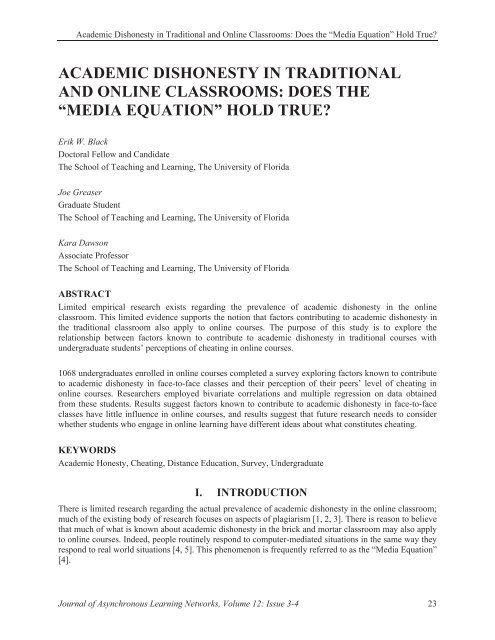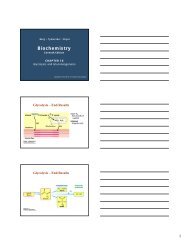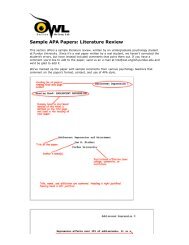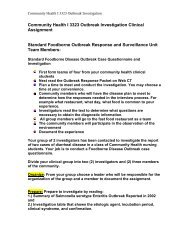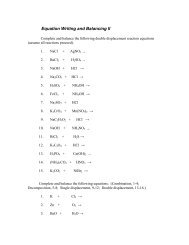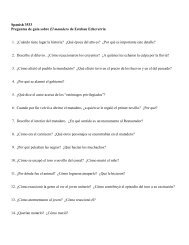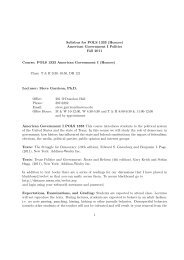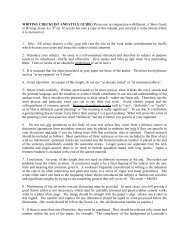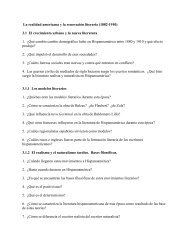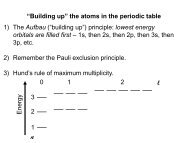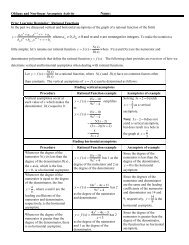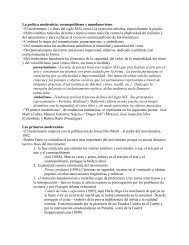Academic Dishonesty in Traditional and Online Classrooms
Academic Dishonesty in Traditional and Online Classrooms
Academic Dishonesty in Traditional and Online Classrooms
Create successful ePaper yourself
Turn your PDF publications into a flip-book with our unique Google optimized e-Paper software.
<strong>Academic</strong> <strong>Dishonesty</strong> <strong>in</strong> <strong>Traditional</strong> <strong>and</strong> Onl<strong>in</strong>e <strong>Classrooms</strong>: Does the “Media Equation” Hold True?<br />
ACADEMIC DISHONESTY IN TRADITIONAL<br />
AND ONLINE CLASSROOMS: DOES THE<br />
“MEDIA EQUATION” HOLD TRUE?<br />
Erik W. Black<br />
Doctoral Fellow <strong>and</strong> C<strong>and</strong>idate<br />
The School of Teach<strong>in</strong>g <strong>and</strong> Learn<strong>in</strong>g, The University of Florida<br />
Joe Greaser<br />
Graduate Student<br />
The School of Teach<strong>in</strong>g <strong>and</strong> Learn<strong>in</strong>g, The University of Florida<br />
Kara Dawson<br />
Associate Professor<br />
The School of Teach<strong>in</strong>g <strong>and</strong> Learn<strong>in</strong>g, The University of Florida<br />
ABSTRACT<br />
Limited empirical research exists regard<strong>in</strong>g the prevalence of academic dishonesty <strong>in</strong> the onl<strong>in</strong>e<br />
classroom. This limited evidence supports the notion that factors contribut<strong>in</strong>g to academic dishonesty <strong>in</strong><br />
the traditional classroom also apply to onl<strong>in</strong>e courses. The purpose of this study is to explore the<br />
relationship between factors known to contribute to academic dishonesty <strong>in</strong> traditional courses with<br />
undergraduate students’ perceptions of cheat<strong>in</strong>g <strong>in</strong> onl<strong>in</strong>e courses.<br />
1068 undergraduates enrolled <strong>in</strong> onl<strong>in</strong>e courses completed a survey explor<strong>in</strong>g factors known to contribute<br />
to academic dishonesty <strong>in</strong> face-to-face classes <strong>and</strong> their perception of their peers’ level of cheat<strong>in</strong>g <strong>in</strong><br />
onl<strong>in</strong>e courses. Researchers employed bivariate correlations <strong>and</strong> multiple regression on data obta<strong>in</strong>ed<br />
from these students. Results suggest factors known to contribute to academic dishonesty <strong>in</strong> face-to-face<br />
classes have little <strong>in</strong>fluence <strong>in</strong> onl<strong>in</strong>e courses, <strong>and</strong> results suggest that future research needs to consider<br />
whether students who engage <strong>in</strong> onl<strong>in</strong>e learn<strong>in</strong>g have different ideas about what constitutes cheat<strong>in</strong>g.<br />
KEYWORDS<br />
<strong>Academic</strong> Honesty, Cheat<strong>in</strong>g, Distance Education, Survey, Undergraduate<br />
I. INTRODUCTION<br />
There is limited research regard<strong>in</strong>g the actual prevalence of academic dishonesty <strong>in</strong> the onl<strong>in</strong>e classroom;<br />
much of the exist<strong>in</strong>g body of research focuses on aspects of plagiarism [1, 2, 3]. There is reason to believe<br />
that much of what is known about academic dishonesty <strong>in</strong> the brick <strong>and</strong> mortar classroom may also apply<br />
to onl<strong>in</strong>e courses. Indeed, people rout<strong>in</strong>ely respond to computer-mediated situations <strong>in</strong> the same way they<br />
respond to real world situations [4, 5]. This phenomenon is frequently referred to as the “Media Equation”<br />
[4].<br />
Journal of Asynchronous Learn<strong>in</strong>g Networks, Volume 12: Issue 3-4 23
<strong>Academic</strong> <strong>Dishonesty</strong> <strong>in</strong> <strong>Traditional</strong> <strong>and</strong> Onl<strong>in</strong>e <strong>Classrooms</strong>: Does the “Media Equation” Hold True?<br />
If students are exhibit<strong>in</strong>g the same behavior <strong>in</strong> onl<strong>in</strong>e courses that they exhibit <strong>in</strong> traditional classrooms,<br />
then <strong>in</strong>structors <strong>and</strong> designers of onl<strong>in</strong>e courses have cause for alarm. A high percentage of students cheat<br />
<strong>in</strong> classroom-based courses [2, 6, 7]. Research suggests various personal <strong>and</strong> environmental factors that<br />
contribute to academic dishonesty [2, 8, 9].<br />
The purpose of this study is to explore the relationship between factors known to contribute to academic<br />
dishonesty <strong>in</strong> traditional courses with undergraduate students’ perceptions of cheat<strong>in</strong>g <strong>in</strong> onl<strong>in</strong>e courses.<br />
Specifically, we explore the relationships between 1068 undergraduate students’ perceptions of the<br />
amount of cheat<strong>in</strong>g occurr<strong>in</strong>g <strong>in</strong> their onl<strong>in</strong>e courses <strong>and</strong> the follow<strong>in</strong>g factors which have been shown to<br />
contribute to academic dishonesty <strong>in</strong> traditional classrooms: (1) the number of credits taken dur<strong>in</strong>g the<br />
semester [10, 11], (2) the number of hours spent weekly on the course [12] , (3) the perceived learn<strong>in</strong>g as<br />
a result of the course [13] <strong>and</strong> (4) the perceived amount of <strong>in</strong>teraction with the <strong>in</strong>structor [14]. As such,<br />
the follow<strong>in</strong>g question guided this exploratory research: Is there a relationship between cheat<strong>in</strong>g <strong>in</strong> onl<strong>in</strong>e<br />
educational environments <strong>and</strong> variables traditionally related to cheat<strong>in</strong>g <strong>in</strong> a traditional educational<br />
environment?<br />
II. METHOD<br />
A. Participants<br />
The participants were 1068 undergraduate students enrolled <strong>in</strong> 12 completely onl<strong>in</strong>e psychology courses<br />
at a Research 1 university. The average class size is 90, with a range from 8 to 312 <strong>and</strong> a st<strong>and</strong>ard<br />
deviation of 80. The classes are populated primarily by 18–22 year-old undergraduate students from a<br />
variety of majors, with the largest concentration be<strong>in</strong>g psychology majors. Reviews of enrollment data<br />
have shown that students <strong>in</strong> these onl<strong>in</strong>e courses are generally <strong>in</strong> later academic years <strong>and</strong> have higher<br />
GPA’s.<br />
B. Instrumentation<br />
The <strong>in</strong>strument used to survey the population (Appendix A) was <strong>in</strong>cluded as part of a question mid-term<br />
technical courseware evaluation. A more sound methodological approach to this research would have<br />
been to supply the survey at the end of the course, unfortunately, this was not logistically possible from<br />
an adm<strong>in</strong>istrative st<strong>and</strong>po<strong>in</strong>t. The first five survey questions dealt with aspects of student academic<br />
perceptions, two question offered students a free response option, these question asked students to report<br />
the number of credits <strong>in</strong> which they were currently enrolled <strong>and</strong> the amount of time they dedicated to<br />
classwork specific to the onl<strong>in</strong>e course. Students responded to the rema<strong>in</strong><strong>in</strong>g academic honesty questions<br />
via five-po<strong>in</strong>t Likert scales. The scales ranged from less likely (1) to more likely (5). The last two<br />
questions were free response items request<strong>in</strong>g student feedback regard<strong>in</strong>g pedagogical <strong>and</strong> technical<br />
improvement of the courses offered to the population. It should be noted that the five po<strong>in</strong>t Likert scales<br />
limited the range of variability of student responses. While this is typically a concern with smaller data<br />
sets, the overall size of the sample (N= 1068) reduced the impact of the limited variability. Because of the<br />
limited number of items constitut<strong>in</strong>g the survey <strong>and</strong> the multidimensional structure of the data, the<br />
calculated Cronbach of .07 will be ignored.<br />
It is important to note that the questionnaire employed did not explicitly seek <strong>in</strong>formation about<br />
respondent’s propensity to cheat or habits of academic honesty or dishonesty. In order to avoid collect<strong>in</strong>g<br />
data constitut<strong>in</strong>g social desirable answers, a concern prevalent with research <strong>in</strong> academic honesty [15], the<br />
researchers asked participants to gauge whether others with<strong>in</strong> their onl<strong>in</strong>e class were engaged <strong>in</strong><br />
24 Journal of Asynchronous Learn<strong>in</strong>g Networks, Volume 12: Issue 3-4
<strong>Academic</strong> <strong>Dishonesty</strong> <strong>in</strong> <strong>Traditional</strong> <strong>and</strong> Onl<strong>in</strong>e <strong>Classrooms</strong>: Does the “Media Equation” Hold True?<br />
academically dishonest practices. Research by Jordan [16] <strong>in</strong>dicates that among cheaters, the perception<br />
that those around them are engaged <strong>in</strong> academically dishonest behavior is more prevalent then amongst<br />
those who do not engage <strong>in</strong> academically dishonest behavior.<br />
C. Data Collection<br />
After the fourth week of class, a l<strong>in</strong>k appeared on each course homepage titled, “Research Survey”. The<br />
target page stated that participation was voluntary, <strong>and</strong> that all submissions were completely anonymous.<br />
In addition, there was a l<strong>in</strong>k to the questionnaire. The questionnaire was adm<strong>in</strong>istered us<strong>in</strong>g the WebCT<br />
course management software’s survey tool. The questionnaire was available for one week. At the end of<br />
the week, the results from each course were downloaded <strong>and</strong> the questionnaire <strong>and</strong> results were deleted<br />
from the course. Results were analyzed <strong>and</strong> <strong>in</strong>terpreted post-hoc utiliz<strong>in</strong>g SAS Bus<strong>in</strong>ess Intelligence <strong>and</strong><br />
Analytics Software [17]. Due to the post-hoc nature of analysis, significance tests were two-tailed <strong>in</strong><br />
nature, result<strong>in</strong>g <strong>in</strong> a m<strong>in</strong>or loss of power. Because of the size of the sample, this loss of power had no<br />
significant effect on the overall results of the study.<br />
D. Data Analysis<br />
This study <strong>in</strong>vestigated the relationship between the <strong>in</strong>dependent variables <strong>and</strong> the perception that others<br />
enrolled with<strong>in</strong> the distance education class were engag<strong>in</strong>g <strong>in</strong> academically dishonest behavior (cheat<strong>in</strong>g).<br />
Independent variables <strong>in</strong>cluded: perceived learn<strong>in</strong>g, perceived <strong>in</strong>teraction, contact hours <strong>and</strong> number of<br />
credit hours currently enrolled. For the purposes of the study, perceived learn<strong>in</strong>g was def<strong>in</strong>ed as the<br />
amount of learn<strong>in</strong>g tak<strong>in</strong>g place with<strong>in</strong> the distance education course as compared to traditional<br />
classroom-based courses. Perceived <strong>in</strong>teraction was def<strong>in</strong>ed as opportunities for <strong>in</strong>teraction with the<br />
<strong>in</strong>structor <strong>and</strong>/or teach<strong>in</strong>g assistant as compared to traditional classroom based courses. Contact hours<br />
were def<strong>in</strong>ed as the number of hours spent dur<strong>in</strong>g an average week complet<strong>in</strong>g course work. The<br />
dependent variable of measure, perceived likelihood of cheat<strong>in</strong>g compared to traditional classroom based<br />
courses, was measured on a five-po<strong>in</strong>t Likert scale. Pearson product-moment correlation coefficients<br />
were utilized to determ<strong>in</strong>e correlations between variables. Multiple l<strong>in</strong>ear regression was employed to<br />
detect the significantly predictive effect of the <strong>in</strong>dependent variables on the dependent variable.<br />
III. RESULTS<br />
A review of descriptive statistics derived from the study (see table 1) reveals that students reported the<br />
perception that there was less cheat<strong>in</strong>g <strong>in</strong> onl<strong>in</strong>e classes as compared to face to face classes (mean = 2.74,<br />
SD = .95). Students also reported perceiv<strong>in</strong>g a higher level of learn<strong>in</strong>g as compared to face to face classes<br />
(mean = 3.32, SD = 1.00). Additionally, students reported perceiv<strong>in</strong>g a lower level of professor <strong>and</strong> TA<br />
<strong>in</strong>teraction as compared to face to face classes (mean = 2.68, SD = 1.25). Pearson product-moment<br />
correlation among all variables were calculated, these results are reported <strong>in</strong> table 2. Multiple regression<br />
analysis of the sample (N=1068) showed that the <strong>in</strong>teraction between the dependent variable (cheat<strong>in</strong>g)<br />
<strong>and</strong> the <strong>in</strong>dependent variables with<strong>in</strong> a s<strong>in</strong>gle block: contact hours, perceived learn<strong>in</strong>g, <strong>in</strong>structor<br />
<strong>in</strong>teraction <strong>and</strong> contact hours were significant F (4, 1068) = 20.6, p < .0001. The model was able to<br />
account for 7% of the variance (adjusted R square = .07, (95% CI= 4.1%, 9.9%). It is important to note<br />
that the effect sizes of each of the <strong>in</strong>teractions are relatively small, thus significance <strong>in</strong> the case of each<br />
<strong>in</strong>teraction may be attributed to the sample size. Table 3 details the results of the multiple regression.<br />
Journal of Asynchronous Learn<strong>in</strong>g Networks, Volume 12: Issue 3-4 25
<strong>Academic</strong> <strong>Dishonesty</strong> <strong>in</strong> <strong>Traditional</strong> <strong>and</strong> Onl<strong>in</strong>e <strong>Classrooms</strong>: Does the “Media Equation” Hold True?<br />
Perceived<br />
Cheat<strong>in</strong>g<br />
Perceived<br />
Learn<strong>in</strong>g<br />
Perceived<br />
Interaction<br />
Contact<br />
Hours<br />
Perceived<br />
Cheat<strong>in</strong>g<br />
Perceived<br />
Learn<strong>in</strong>g<br />
Perceived<br />
Interaction<br />
Contact<br />
Hours<br />
Table 1: Descriptive Statistics (n=1068)<br />
Mean St<strong>and</strong>ard<br />
Deviation<br />
2.74 .95<br />
3.32 1.00<br />
2.68 1.25<br />
3.36 2.26<br />
Credits 13.7 2.74<br />
Table 2: Correlations Between Variables for All Subjects (n=1068)<br />
Cheat<strong>in</strong>g Learn<strong>in</strong>g Interaction Contact Credits<br />
1.00 -.20* -.09* -.18* -.01<br />
-.20* 1.00 .37* .04 .03<br />
-.09* .37* 1.00 .01 -.02<br />
-.18* .04 .01 1.00 .10*<br />
Credits -.01 .03 -.02 .10* 1.00<br />
* p < .05<br />
Table 3: Results of the Multiple Regression Analysis of Cheat<strong>in</strong>g <strong>and</strong> the Four Independent Variables (n=1068)<br />
Perceived<br />
Learn<strong>in</strong>g<br />
Perceived<br />
Interaction<br />
Contact<br />
Hours<br />
St<strong>and</strong>ard<br />
Error <br />
t Significance<br />
-.19 .03 -5.88
<strong>Academic</strong> <strong>Dishonesty</strong> <strong>in</strong> <strong>Traditional</strong> <strong>and</strong> Onl<strong>in</strong>e <strong>Classrooms</strong>: Does the “Media Equation” Hold True?<br />
Table 4: Squared Partial Correlations Between Cheat<strong>in</strong>g <strong>and</strong> Four Independent Variables for All Subjects (n=1068)<br />
Perceived<br />
Learn<strong>in</strong>g<br />
Perceived<br />
Interaction<br />
Contact<br />
Hours<br />
Squared<br />
Semi-Partial<br />
Correlation<br />
.0300 .0300<br />
.0005 .0005<br />
.0300 .0300<br />
Credits .0001 .0001<br />
Squared<br />
Partial<br />
Correlation<br />
Table 5: Pearson Product Moment Correlations: Cheat<strong>in</strong>g <strong>and</strong> Four Independent Variables for All Subjects (n=1068)<br />
Perceived<br />
Cheat<strong>in</strong>g<br />
Perceived<br />
Learn<strong>in</strong>g<br />
Perceived<br />
Interaction<br />
Contact<br />
Hours<br />
Perceived<br />
Cheat<strong>in</strong>g<br />
Perceived<br />
Learn<strong>in</strong>g<br />
Perceived<br />
Interaction<br />
Contact Credits<br />
1.00 -.2* -.09* -.18* -.01<br />
-.2* 1.00 .37* .05 .03<br />
-.09* .37* 1.00 .013 -.02<br />
-.18* .04 .01 1.00 .10*<br />
Credits -.01 .03 -.02 .10* 1.00<br />
* p < .05<br />
A. Measure I: Perceived Cheat<strong>in</strong>g <strong>and</strong> Perceived Learn<strong>in</strong>g<br />
The data <strong>in</strong>dicates that a m<strong>in</strong>or <strong>in</strong>verse relationship between perceived cheat<strong>in</strong>g <strong>and</strong> perceived learn<strong>in</strong>g<br />
when other factors are held constant. This <strong>in</strong>dicates that those who perceived they were learn<strong>in</strong>g more<br />
with<strong>in</strong> their classes were less likely to perceive that there is cheat<strong>in</strong>g occurr<strong>in</strong>g with<strong>in</strong> their onl<strong>in</strong>e course.<br />
While the f<strong>in</strong>d<strong>in</strong>gs were significant, the correlation between the two variables was relatively small at -.2<br />
(see table 5). Application of multiple regression reveals a squared semi-partial correlation of .030 (see<br />
table 4). The squared partial correlation measures the association between the dependent variable,<br />
cheat<strong>in</strong>g, <strong>and</strong> perceived learn<strong>in</strong>g with all other variables held constant. Our analysis <strong>in</strong>dicates that of the<br />
variance <strong>in</strong> cheat<strong>in</strong>g not associated with <strong>in</strong>structor <strong>in</strong>teraction, credit hours <strong>and</strong> contact hours, on average,<br />
3% is associated with perceived cheat<strong>in</strong>g.<br />
B. Measure II: Perceived Cheat<strong>in</strong>g <strong>and</strong> Perceived Instructor Interaction<br />
The data <strong>in</strong>dicates that a m<strong>in</strong>or <strong>in</strong>verse relationship exists between <strong>in</strong>teraction with <strong>in</strong>structors <strong>and</strong> faculty<br />
<strong>and</strong> cheat<strong>in</strong>g when other factors are held constant. Mean<strong>in</strong>g that, students who had more <strong>in</strong>teractions with<br />
their <strong>in</strong>structors <strong>and</strong> faculty were less likely to feel cheat<strong>in</strong>g was occurr<strong>in</strong>g with<strong>in</strong> their onl<strong>in</strong>e course.<br />
While the f<strong>in</strong>d<strong>in</strong>gs were statistically significant, it is important to note that the spurious correlation<br />
between these two variables is extremely small at -.09 (see table 5). Application of multiple regression<br />
reveals a squared partial correlation of .0005 (see table 4). The squared partial correlation measures the<br />
association between the dependent variable, cheat<strong>in</strong>g, <strong>and</strong> <strong>in</strong>structor <strong>in</strong>teraction with all other variables<br />
Journal of Asynchronous Learn<strong>in</strong>g Networks, Volume 12: Issue 3-4 27
<strong>Academic</strong> <strong>Dishonesty</strong> <strong>in</strong> <strong>Traditional</strong> <strong>and</strong> Onl<strong>in</strong>e <strong>Classrooms</strong>: Does the “Media Equation” Hold True?<br />
held constant. Our analysis <strong>in</strong>dicates that of the variance <strong>in</strong> perceived cheat<strong>in</strong>g not associated with<br />
learn<strong>in</strong>g, credit hours <strong>and</strong> contact hours, on average .054 is associated with <strong>in</strong>structor <strong>in</strong>teraction.<br />
E. Measure III: Perceived Cheat<strong>in</strong>g <strong>and</strong> Contact Hours<br />
The data <strong>in</strong>dicates that a m<strong>in</strong>or <strong>in</strong>verse relationship between the perceived cheat<strong>in</strong>g <strong>and</strong> contact hours.<br />
This <strong>in</strong>dicates that those who spent more time engaged <strong>in</strong> course oriented activity were less likely to<br />
perceive that cheat<strong>in</strong>g was occurr<strong>in</strong>g with<strong>in</strong> their onl<strong>in</strong>e course. While the f<strong>in</strong>d<strong>in</strong>gs were significant, the<br />
spurious correlation between the two variables was relatively small at -.18 (see table 5). Application of<br />
multiple regression reveals a squared partial correlation of .030 (see table 4). The squared partial<br />
correlation measures the association between the dependant variable, perceived cheat<strong>in</strong>g, <strong>and</strong> contact<br />
hours with all other variables held constant. Our analysis <strong>in</strong>dicates that of the variance <strong>in</strong> perceived<br />
cheat<strong>in</strong>g not associated with <strong>in</strong>structor <strong>in</strong>teraction, credit hours <strong>and</strong> perceived learn<strong>in</strong>g, on average 3% is<br />
associated with <strong>in</strong>structor <strong>in</strong>teraction.<br />
F. Measure IV: Perceived Cheat<strong>in</strong>g <strong>and</strong> Credit Hours<br />
The data <strong>in</strong>dicates that an extremely small <strong>in</strong>verse but non-significant relationship (at the .05 level)<br />
between perceived cheat<strong>in</strong>g <strong>and</strong> the number of credit hours that a student was enrolled <strong>in</strong>, when other<br />
factors are held constant. This <strong>in</strong>dicates that there is no relationship between the number of credit hours<br />
that a student enrolls <strong>in</strong> <strong>and</strong> perceptions of cheat<strong>in</strong>g with<strong>in</strong> an onl<strong>in</strong>e course. <br />
IV. DISCUSSION<br />
The results of this study represent significant f<strong>in</strong>d<strong>in</strong>gs that deviate from traditional views regard<strong>in</strong>g<br />
cheat<strong>in</strong>g <strong>in</strong> onl<strong>in</strong>e courses. Our research suggests ideas regard<strong>in</strong>g the factors that <strong>in</strong>fluence academic<br />
dishonesty <strong>in</strong> an onl<strong>in</strong>e course need to be adjusted. While our results <strong>in</strong>dicated that the <strong>in</strong>dependent<br />
variables accounted for a statistically significant amount of variance with<strong>in</strong> the dependent variable, this<br />
amount was relatively small (adjusted R square = .07).<br />
Kennedy, Nowak, Thomas <strong>and</strong> Davis [18] have asserted that distance learn<strong>in</strong>g environments provide <strong>and</strong><br />
promote opportunities for academic dishonesty to a degree greater then found <strong>in</strong> traditional learn<strong>in</strong>g<br />
environments. The data reported with<strong>in</strong> this study directly refutes this claim, <strong>in</strong>stead <strong>in</strong>dicat<strong>in</strong>g that a vast<br />
majority of students (81%) feel that cheat<strong>in</strong>g with<strong>in</strong> their onl<strong>in</strong>e course is no more prevalent then cheat<strong>in</strong>g<br />
with<strong>in</strong> a traditional course. These results concur with the idea that beliefs regard<strong>in</strong>g the rampant nature of<br />
cheat<strong>in</strong>g with<strong>in</strong> onl<strong>in</strong>e learn<strong>in</strong>g environments are based on anecdotal evidence at best <strong>and</strong> an argumentum<br />
ad populum at worst [19]. While this may be an encourag<strong>in</strong>g notion, it is important to remember that<br />
regardless of whether <strong>in</strong> face-to-face classrooms or onl<strong>in</strong>e, today’s college students are engag<strong>in</strong>g <strong>in</strong><br />
academically dishonest practices with <strong>in</strong>creas<strong>in</strong>g prevalence [20, 21, 22].<br />
Ultimately, there may be the need to consider whether students engaged <strong>in</strong> onl<strong>in</strong>e education have a<br />
fundamentally different perception of what does <strong>and</strong> does not constitute cheat<strong>in</strong>g compared to those <strong>in</strong><br />
traditional educational environments.<br />
V. CONCLUSIONS<br />
Our f<strong>in</strong>d<strong>in</strong>gs were unable to directly substantiate motivations for cheat<strong>in</strong>g with<strong>in</strong> an onl<strong>in</strong>e learn<strong>in</strong>g<br />
environment. Our supposition was that the factors that <strong>in</strong>fluence academic honesty with<strong>in</strong> traditional<br />
28 Journal of Asynchronous Learn<strong>in</strong>g Networks, Volume 12: Issue 3-4
<strong>Academic</strong> <strong>Dishonesty</strong> <strong>in</strong> <strong>Traditional</strong> <strong>and</strong> Onl<strong>in</strong>e <strong>Classrooms</strong>: Does the “Media Equation” Hold True?<br />
learn<strong>in</strong>g sett<strong>in</strong>gs would also have significant <strong>in</strong>fluence <strong>and</strong> effect on academic honesty <strong>in</strong> onl<strong>in</strong>e learn<strong>in</strong>g<br />
environments. This hypothesis did not hold true, provid<strong>in</strong>g an opportunity to question Reeves <strong>and</strong> Nass’s<br />
[4] “media equation” phenomenon. Based on the results of the study it is appropriate to evaluate whether<br />
onl<strong>in</strong>e students def<strong>in</strong>e cheat<strong>in</strong>g <strong>in</strong> the same manner as those engaged <strong>in</strong> traditional educational<br />
environments. Additional studies to gauge this underst<strong>and</strong><strong>in</strong>g are needed. In addition, qualitative analysis<br />
should be employed <strong>in</strong> order to ga<strong>in</strong> a comprehensive perspective regard<strong>in</strong>g measurable constructs that<br />
could be utilized with<strong>in</strong> a valid <strong>and</strong> reliable <strong>in</strong>strument to obta<strong>in</strong> a measure academic honesty <strong>in</strong> onl<strong>in</strong>e<br />
educational environments.<br />
VI. ABOUT THE AUTHORS<br />
Erik Black <strong>and</strong> Joe Greaser are graduate students <strong>in</strong> the University of Florida’s School of Teach<strong>in</strong>g &<br />
Learn<strong>in</strong>g. Kara Dawson is an Associate Professor <strong>in</strong> the University of Florida College of Education.<br />
VII. REFERENCES<br />
1. Campbell, C.R., C. O. Swift & L. T. Denton. Cheat<strong>in</strong>g goes hi-tech: Onl<strong>in</strong>e term paper mills.<br />
Journal of Management Education 24(6): 726–744, 2000.<br />
2. Ercegovac, Z. & J. Richardson. (2004). <strong>Academic</strong> dishonesty, plagiarism <strong>in</strong>cluded, <strong>in</strong> the digital<br />
age: a literature review. College & Research Libraries 65(4): 2004.<br />
3. Sterngold, A. Confront<strong>in</strong>g plagiarism: How conventional teach<strong>in</strong>g <strong>in</strong>vites cybercheat<strong>in</strong>g. Change 36:<br />
2004. Retrieved March 24, 2007, from InfoTrac database.<br />
4. Reeves, B. & C. Nass. The Media Equation : How People Treat Computers, Television, <strong>and</strong> New<br />
Media Like Real People <strong>and</strong> Places. Stanford, CA: Center for the Study of Language <strong>and</strong> Inf; Repr<strong>in</strong>t<br />
edition, 2003.<br />
5. Ferdig, R. E. & P. Mishra. Emotional responses to computers: experiences <strong>in</strong> unfairness, anger, <strong>and</strong><br />
spite. Journal of Educational Multimedia <strong>and</strong> Hypermedia 13(2): 143–162, 2004.<br />
6. McCabe, D. L., L. K. Trev<strong>in</strong>o & K. D. Butterfield. <strong>Dishonesty</strong> <strong>in</strong> academic environments: The<br />
<strong>in</strong>fluence of peer report<strong>in</strong>g requirements. The Journal of Higher Education 71(1): 2001.<br />
7. Scanlon, P. M. Student onl<strong>in</strong>e plagiarism: How do we respond? College Teach<strong>in</strong>g 51(4): 161–5,<br />
2003.<br />
8. Tanner, C. A. Moral decl<strong>in</strong>e or pragmatic decision mak<strong>in</strong>g?: Cheat<strong>in</strong>g <strong>and</strong> plagiarism <strong>in</strong> perspective.<br />
Journal of Nurs<strong>in</strong>g Education 43(7): 291–2, 2004.<br />
9. Underwood, J. & A. Szabo. <strong>Academic</strong> offenses <strong>and</strong> e-learn<strong>in</strong>g: Propensities <strong>in</strong> cheat<strong>in</strong>g. British<br />
Journal of Educational Technology 34(4): 467–77, 2003.<br />
10. Kerkvliet, J. & C. L. Sigmund. Can we control cheat<strong>in</strong>g <strong>in</strong> the classroom? Journal of Economic<br />
Education 30(4): 331, 1999.<br />
11. Whitley, B. E. Factors associated with cheat<strong>in</strong>g among college students: A review. Research <strong>in</strong><br />
Higher Education 39(4): 1998.<br />
12. Franklyn-Stokes, A. & S. E. Newstead. Undergraduate cheat<strong>in</strong>g: Who does what <strong>and</strong> why? Studies<br />
<strong>in</strong> Higher Education 20(2): 159–172, 1995.<br />
13. Wryobeck, J. M., B. E. Whitley & E. Bernard. Educational value orientation <strong>and</strong> peer perceptions<br />
of cheaters. Ethics & Behavior 9(3): 1999.<br />
14. Born, A. D. Teach<strong>in</strong>g tip: How to reduce plagiarism. Journal of Information Systems Education<br />
14(3): 2003.<br />
15. Sudman, S. & N. Bradburn. Response effects <strong>in</strong> surveys: A review <strong>and</strong> synthesis. Chicago: Ald<strong>in</strong>e,<br />
1974.<br />
16. Jordan, A. E. College student cheat<strong>in</strong>g: The role of motivation, perceived norms, attitudes <strong>and</strong><br />
knowledge of <strong>in</strong>stitutional policy. Ethics & Behavior 11(3): 2001.<br />
Journal of Asynchronous Learn<strong>in</strong>g Networks, Volume 12: Issue 3-4 29
<strong>Academic</strong> <strong>Dishonesty</strong> <strong>in</strong> <strong>Traditional</strong> <strong>and</strong> Onl<strong>in</strong>e <strong>Classrooms</strong>: Does the “Media Equation” Hold True?<br />
17. SAS. SAS Bus<strong>in</strong>ess Intelligence <strong>and</strong> Analytics Software, 2006. Retrieved November 9, 2006 from<br />
http://www.sas.com/.<br />
18. Kennedy, K., S. Nowak, J. Thomas & S. Davis. <strong>Academic</strong> dishonesty <strong>and</strong> distance learn<strong>in</strong>g:<br />
Student <strong>and</strong> faculty views. The College Student Journal 34(2): 309, 2000.<br />
19. Baron, J. & S. M. Crooks. <strong>Academic</strong> <strong>in</strong>tegrity <strong>in</strong> web based distance education. TechTrends 49(2):<br />
40–45, 2005.<br />
20. McCabe, D. L. & L. K. Trev<strong>in</strong>o. What we know about cheat<strong>in</strong>g <strong>in</strong> college. Change 28(1): 28–34,<br />
1996.<br />
21. McCabe, D. L. & W. J. Bowers. <strong>Academic</strong> dishonesty among male college students: A thirty-year<br />
perspective. Journal of College Student Development 35(1): 3–10, 1994.<br />
22. McCabe, D. L. & L. K. Trev<strong>in</strong>o. <strong>Academic</strong> dishonesty: Honor codes <strong>and</strong> other contextual<br />
<strong>in</strong>fluences. Journal of Higher Education 64(5): 522–538, 1993.<br />
VIII. APPENDIX A<br />
Dear Student,<br />
We at the Psychology Department would like to ensure that we are serv<strong>in</strong>g your educational needs effectively<br />
<strong>in</strong> our web-based courses. In order to help us do so, we would greatly appreciate you tak<strong>in</strong>g just 2–3 m<strong>in</strong>utes to<br />
give us your feedback on these important questions.<br />
1. What is the total number of credit hours you are currently enrolled <strong>in</strong>?<br />
2. Compared to classroom-based courses I have taken <strong>in</strong> psychology, my experience is that the students<br />
<strong>in</strong> this onl<strong>in</strong>e course are:<br />
a. 1 = Less likely to cheat then <strong>in</strong> face to face courses<br />
b. 2<br />
c. 3 = As likely to cheat as <strong>in</strong> face to face courses<br />
d. 4<br />
e. 5 = More likely to cheat then <strong>in</strong> face to face courses<br />
3. Compared to classroom-based courses I have taken <strong>in</strong> psychology, I am learn<strong>in</strong>g…<br />
a. 1 = Less then <strong>in</strong> face to face courses<br />
b. 2<br />
c. 3 = As much as <strong>in</strong> face to face courses<br />
d. 4<br />
e. 5 = More then <strong>in</strong> face to face courses<br />
4. Compared to other regular on-site courses I have taken <strong>in</strong> psychology, my experience is that <strong>in</strong> this<br />
onl<strong>in</strong>e course the opportunities for <strong>in</strong>teraction with the <strong>in</strong>structor <strong>and</strong> TA are:<br />
a. 1 = Less frequent than <strong>in</strong> face to face courses<br />
b. 2<br />
c. 3 = As frequently as <strong>in</strong> face to face courses<br />
d. 4<br />
e. 5 = More frequent than <strong>in</strong> face to face courses<br />
5. How many hours a week do you spend, on average, complet<strong>in</strong>g course work (<strong>in</strong>clude ALL activities)?<br />
30 Journal of Asynchronous Learn<strong>in</strong>g Networks, Volume 12: Issue 3-4


